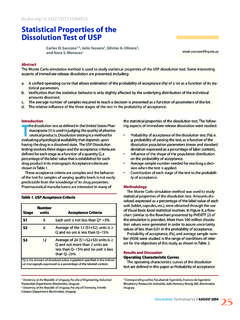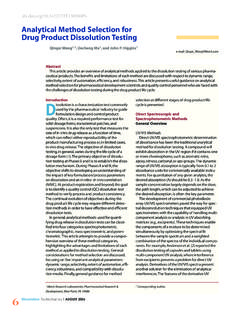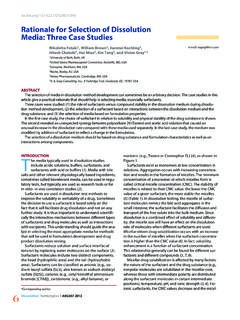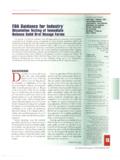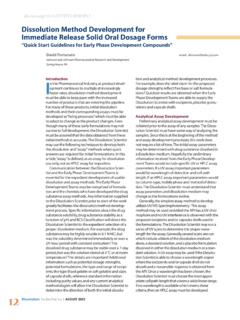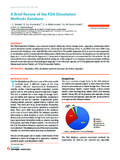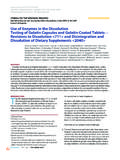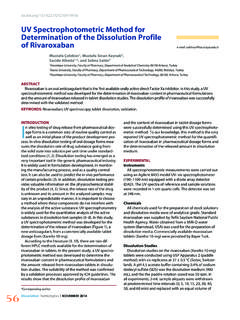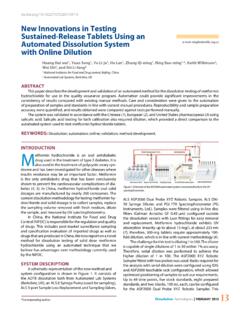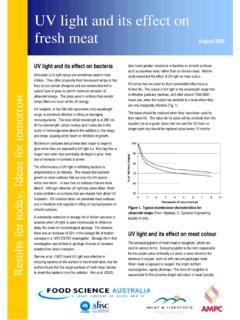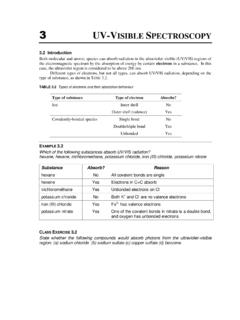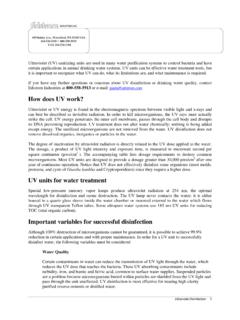Transcription of In-Situ Dissolution Testing Using Different UV Fiber Optic ...
1 In-Situ Dissolution Testing Using Different UV Fiber Optic Probes and Instruments Xujin Lu1, 2, Ruben Lozano2, Pankaj Shah2. Email: Abstract: In-Situ Dissolution Testing Using UV Fiber optics has attracted much attention in the pharmaceutical industry. Several instruments with Different designs of Fiber Optic probes have been applied for this Testing . These instruments employ Different types of spectrometers and the probes differ in shape, light beam path, and sampling window. These differences may have significant impact on the Dissolution operations and results. In this article we will examine these instruments and probes and discuss the effects of their charac- teristics on Dissolution Testing .
2 Introduction: turers in the United States introduced their inde- Fiber Optic technology for Dissolution Testing has pendently developed instruments one after been a topic of interest for many researchers for another. These commercial instruments employed some years. Josefson, Johansson, and Tortensson 1 either a spectrometer with multi-channel CCDs 10, 11. published early research in this field in 1988. They , multiple PDA spectrometers 12,13, or a scanning explored the feasibility of Using UV Fiber optics for spectrometer with a mechanical multiplexer 14,15. In-Situ Dissolution and to overcome sample Commercialization of this technology and its turbidity interference without filtration.
3 In 1993, consequent availability to a broad range of users Brown and Lin 2 used a single optical Fiber and a has attracted much attention from the pharmaceu- photo diode array (PDA) UV/vis spectrometer to tical industry. Recent publications and research track Dissolution in a single vessel. Their work was works further described the capability of this tech- extended thereafter to use six optical fibers and a nology 16-18 and demonstrated that UV Fiber optics PDA spectrometer for multiple Dissolution vessels is a breakthrough for Dissolution Testing . A regula- 3. In 1995, Cho and coworkers developed a seven- tory perspective on this technology has also been channel Fiber Optic Dissolution system Using a discussed in a recent article 19.
4 Spectrometer with two-dimensional charge- coupled devices (CCD), which allowed the simulta- Why Fiber Optic Dissolution ? neous monitoring of six Dissolution vessels and a Traditionally, Dissolution Testing has been seventh reference vessel 4,5. Several other studies conducted by manually or automatically removing around the same time further explored the possi- samples from Dissolution vessels, and then bility of Using Fiber Optic technology for special bringing the samples either to a UV spectrometer Dissolution applications. For example, Chen and his for determination of the analyte concentration, or group 6,7 employed a Fiber Optic based chemical to a HPLC for UV or fluorescence detection after sensor for continuous monitoring of In-Situ dissolu- separation.
5 The use of Fiber optics changes this tion. Gemperline et al 8 applied a CCD/ Fiber Optic traditional way of sampling. Instead of bringing the system for determining two-component dissolu- samples to a UV spectrometer, Fiber optics brings tion profiles of a pharmaceutical product, which the UV spectrometer to the sample solutions. A. used a full-range spectral principal component real-time drug release level is determined In-Situ or regression methodology. Aldridge and coworkers 9 in the vessels without sample removal. automated a single-probe Fiber Optic system that In-Situ Dissolution Using Fiber optics has signifi- used a robot arm to move the probe from vessel to cant advantages over traditional Dissolution .
6 The vessel for sequential Testing . All these break- labor-intensive manual sampling procedure is through studies had great impact on subsequent eliminated and the Testing procedure is simplified. development of commercial instruments and It is more economical because consumables for established the platform for modern In-Situ Fiber sampling, such as pipettes, syringes, sippers, tubing, Optic Dissolution Testing . and filters, are not needed. Without sampling, it Commercial UV Fiber Optic Dissolution instru- creates a new way for automation consideration. In ments became available in 1999. Several manufac- addition, Fiber optics can generate more frequent 1 2.
7 Corresponding author,Senior Research Investigator,Pharmaceutical Pharmaceutical Research Institute,Bristol-Myers Squibb Company,Analytical Research Institute,Bristol-Myers Squibb Company,Analytical R&D,One Squibb R&D,New Brunswick,NJ. Drive,New Brunswick,NJ 08903,email: Dissolution Technologies | NOVEMBER 2003. 6. data points and produce a more detailed Dissolution vessel. (2) Rod probe, essentially a solid rod dipped in the profile, which may be very beneficial for showing a vessel, with a detection window in the traditional sampling method's discriminating ability. location defined by USP. There are two types of rod probe made by Different vendors with slightly Different sizes and Challenges of Fiber Optic Dissolution with a built-in mirror or lens.
8 (3) Arch probe, which has an Although Fiber Optic Dissolution has advantages, it also arch shape and a detection window in the traditional USP. faces a number of challenges. First, Dissolution is a restric- sampling location. These probe types have Different tively regulated test. It takes time for scientists, managers, dimensions, light beam paths, and sampling windows, and regulatory agencies in the pharmaceutical industry to which may significantly affect the Dissolution Testing . accept replacement of current methodology with a new These effects maybe due to changes in hydrodynamics, technique. Second, Fiber optics is a cutting edge tech- stray light, light scattering, particulate accumulation, etc.
9 Nology with a relatively short history of Dissolution appli- The purpose of this study was to examine Different types cations. The instrumentation is not yet mature, and of UV Fiber Optic instrumentation and to evaluate the optimization of the hardware and software is still in effects of their spectroscopic characteristics on Dissolution progress. Furthermore, to most users, the Different spectro- Testing . Experimental results and pharmaceutical applica- scopic designs among the commercial instruments tion examples will be discussed to demonstrate the char- complicate its selection and implementation. For example, acteristics of the technology and the limitations of the an instrument with a conventional scanning UV spectrom- instrumentation.
10 Eter may detect Dissolution solutions in six or twelve vessels in a sequential mode, whereas an instrument with Experimental and Materials PDA or CCD devices may detect these solutions simultane- Instrumentation ously. Users have to understand these Different character- Three UV Fiber Optic instruments were used in this study istics and their impact in order to develop a Fiber Optic (Figure 2). They were: (1) Opt-Diss Fiber Optic UV system method and conduct a successful Dissolution test. (Leap Technologies Inc.) with a multi-channel CCD spec- In addition to Different spectroscopic designs, the UV trometer (205 - 410 nm), one set of six shaft probes (path- Fiber Optic probes provided with Different instruments add length 1 cm), two sets of six arch probes (pathlengths of 1.)
